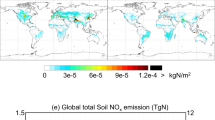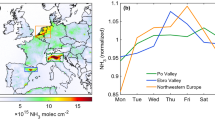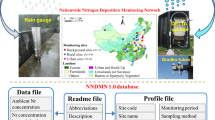Abstract
Global ammonia emissions have more than doubled since pre-industrial times, largely owing to agricultural intensification and widespread fertilizer use1. In the atmosphere, ammonia accelerates particulate matter formation, thereby reducing air quality. When deposited in nitrogen-limited ecosystems, ammonia can act as a fertilizer. This can lead to biodiversity reductions in terrestrial ecosystems, and algal blooms in aqueous environments2,3,4,5,6,7,8. Despite its ecological significance, there are large uncertainties in the magnitude of ammonia emissions, mainly owing to a paucity of ground-based observations and a virtual absence of atmospheric measurements3,8,9,10,11. Here we use infrared spectra, obtained by the IASI/MetOp satellite, to map global ammonia concentrations from space over the course of 2008. We identify several ammonia hotspots in middle–low latitudes across the globe. In general, we find a good qualitative agreement between our satellite measurements and simulations made using a global atmospheric chemistry transport model. However, the satellite data reveal substantially higher concentrations of ammonia north of 30∘ N, compared with model projections. We conclude that ammonia emissions could have been significantly underestimated in the Northern Hemisphere, and suggest that satellite monitoring of ammonia from space will improve our understanding of the global nitrogen cycle.
This is a preview of subscription content, access via your institution
Access options
Subscribe to this journal
Receive 12 print issues and online access
$259.00 per year
only $21.58 per issue
Buy this article
- Purchase on Springer Link
- Instant access to full article PDF
Prices may be subject to local taxes which are calculated during checkout



Similar content being viewed by others
References
Galloway, J. N. et al. The nitrogen cascade. BioScience 53, 341–353 (2003).
Sutton, M. A., Reis, S. & Baker, S. M. H. (eds) Atmospheric Ammonia (Springer, 2009).
Asman, W. A., Sutton, M. A. & Schjørring, J. K. Ammonia: Emission, atmospheric transport and deposition. New Phytol. 139, 27–48 (1998).
Galloway, J. N. et al. Nitrogen cycles: Past, present and future. Biogeochemistry 70, 153–226 (2004).
Sutton, M. A., Erisman, J. W., Dentener, F. & Möller, D. Ammonia in the environment: From ancient times to the present. Environ. Pollut. 156, 583–604 (2008).
Krupa, S. V. Effects of atmospheric ammonia (NH3) on terrestrial vegetation: A review. Environ. Pollut. 124, 179–221 (2003).
Erisman, J. W., Bleeker, A., Galloway, J. & Sutton, M. S. Reduced nitrogen in ecology and the environment. Environ. Pollut. 150, 140–149 (2007).
Galloway, J. N. et al. Transformation of the nitrogen cycle: Recent trends, questions, and potential solutions. Science 320, 889–892 (2008).
Dentener, F. J. & Crutzen, P. J. A three-dimensional model of the global ammonia cycle. J. Atmos. Chem. 19, 331–369 (1994).
Bouwman, A. F. et al. A global high-resolution emission inventory for ammonia. Glob. Biogeochem. Cycles 11, 561–587 (1997).
Matthews, E. Nitrogenous fertilizers: Global distribution of consumption and associated emissions of nitrous oxide and ammonia. Glob. Biogeochem. Cycles 8, 411–439 (1994).
Larsen, L., Roth, B., Van Dingenen, R. & Raes, F. Photolytic aerosol formation in SO2–HNO2–H2O–air mixtures, with and without NH3 . J. Aerosol. Sci. 28, S719–S720 (1997).
Anderson, N., Strader, R. & Davidson, C. Airborne reduced nitrogen: Ammonia emissions from agriculture and other sources. Environ. Int. 29, 277–286 (2003).
Malm, W. C., Schichtel, B. A., Pitchford, M. L., Ashbaugh, L. L. & Eldred, R. A. Spatial and monthly trends in speciated fine particle concentration in the United States. J. Geophys. Res. 109, D03306 (2004).
Sutton, M. A. et al. Challenges in quantifying biosphere–atmosphere exchange of nitrogen species. Environ. Pollut. 150, 125–139 (2007).
Beer, R. et al. First satellite observations of lower tropospheric ammonia and methanol. Geophys. Res. Lett. 35, L09801 (2008).
Clerbaux, C. et al. The IASI/MetOp I Mission: First observations and highlights of its potential contribution to GMES. COSPAR Inf. Bul. 2007, 19–24 (2007).
Clerbaux, C. et al. Monitoring of atmospheric composition using the thermal infrared IASI/MetOp sounder. Atmos. Chem. Phys. Discuss. 9, 8307–8339 (2009).
Streets, D. G. et al. An inventory of gaseous and primary aerosol emissions in Asia in the year 2000. J. Geophys. Res. 108, 8809 (2003).
Coheur, P.-F., Clarisse, L., Turquety, S., Hurtmans, D. & Clerbaux, C. IASI measurements of reactive trace species in biomass burning plumes. Atmos. Chem. Phys. Discuss. 9, 8757–8789 (2009).
Battye, W., Aneja, V. P. & Roelle, P. A. Evaluation and improvement of ammonia emissions inventories. Atmos. Environ. 37, 3873–3883 (2003).
Carmichael, G. R. et al. Measurements of sulfur dioxide, ozone and ammonia concentrations in Asia, Africa, and South America using passive samplers. Atmos. Environ. 37, 1293–1308 (2003).
Scheer, C., Wassmann, R., Kienzler, K., Ibragimov, N. & Eschanov, R. Nitrous oxide emissions from fertilized, irrigated cotton (Gossypium hirsutum L) in the Aral Sea Basin, Uzbekistan: Influence of nitrogen applications and irrigation practices. Soil Biol. Biochem. 40, 290–301 (2008).
Li, J. et al. Characteristics and sources of air-borne particulate in Urumqi, China, the upstream area of Asia dust. Atmos. Environ. 42, 776–787 (2008).
Rodgers, C. Inverse Methods for Atmospheric Sounding: Theory and Practice (World Scientific, 2000).
Coheur, P.-F. Retrieval and characterization of ozone vertical profiles from a thermal infrared nadir sounder. J. Geophys. Res. 110, D24303 (2005).
US Standard Atmosphere, 1976 (US Government Printing Office, 1976).
Acknowledgements
IASI has been developed and built under the responsibility of the Centre National d’Etudes Spatiales (CNES, France). It is flown onboard the MetOp satellites as part of the EUMETSAT Polar System. The IASI L1 data are received through the EUMETCast near-real-time data distribution service. L.C. and P.-F.C. are respectively a Scientific Research Worker (Collaborateur Scientifique) and Research Associate (Chercheur Qualifié) with F.R.S.-FNRS. C.C. is grateful to CNES for scientific collaboration and financial support. The research in Belgium was financially supported by the F.R.S.-FNRS (M.I.S. nF.4511.08), the Belgian State Federal Office for Scientific, Technical and Cultural Affairs and the European Space Agency (ESA-Prodex arrangements C90-327). Financial support by the ‘Actions de Recherche Concertées’ (Communauté Française de Belgique) is also acknowledged. We would like to thank M. Van Damme for his assistance.
Author information
Authors and Affiliations
Contributions
L.C. obtained the first NH3 global distributions, carried out the retrievals and the analyses, drafted the manuscript and prepared the figures. C.C. had an active role in the development of the IASI mission for the atmospheric composition aspects, and supervised the project. F.D. developed the model simulations and provided interpretation of the results. D.H. was responsible for the development of forward and inverse models. P.-F.C. made the first observations of NH3 from IASI, designed the filter and supervised the project. All authors contributed actively to the discussions of the results and preparation of the manuscript.
Corresponding author
Supplementary information
Supplementary Fig. S1
Supplementary Information (PDF 1346 kb)
Rights and permissions
About this article
Cite this article
Clarisse, L., Clerbaux, C., Dentener, F. et al. Global ammonia distribution derived from infrared satellite observations. Nature Geosci 2, 479–483 (2009). https://doi.org/10.1038/ngeo551
Received:
Accepted:
Published:
Issue Date:
DOI: https://doi.org/10.1038/ngeo551
This article is cited by
-
The First Global Map of Atmospheric Ammonia (NH3) as Observed by the HIRAS/FY-3D Satellite
Advances in Atmospheric Sciences (2024)
-
Spatial and temporal patterns of nutrients and their environmental impacts from the agriculture sector in India
Regional Environmental Change (2023)
-
Significant contributions of combustion-related sources to ammonia emissions
Nature Communications (2022)
-
On the weekly cycle of atmospheric ammonia over European agricultural hotspots
Scientific Reports (2022)
-
Impact assessment of Beirut explosion on local and regional air quality
Air Quality, Atmosphere & Health (2021)



